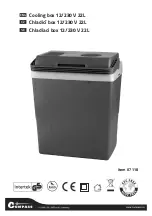
Rittal Liquid Cooling Package
91
19 Glossary
EN
19
Glossary
1 U server:
1 U servers are very flat and deep, modern high per-
formance servers, whose height corresponds to one
height unit (1 U = 44.54 mm, the smallest standard
height division). Typical dimensions are (W x D x H)
482.6 mm (19") x 800 mm x 1 U.
These systems normally include 2 CPUs, many GB
RAM and hard drives, so that they require up to
100 m
3
/h cooling air at a maximum of 32 °C.
482.6 mm (19") level:
The front sides of the devices built into the server
enclosure form the 482.6 mm (19") level.
Blade server:
By orienting dual CPU systems vertically and plac-
ing up to 14 units on a common backplane to pro-
vide for signal routing and power supply, one has a
blade server.
Blade servers can "generate" up to 4.5 kW heat loss
per 7 U and 700 mm depth.
"Front to back" cooling principle:
The devices built into the server enclosure are nor-
mally cooled according to the "front to back" cooling
principle.
Under this cooling principle, cold air supplied by ex-
ternal air conditioning is blown to the front of the
server enclosure. The fans in the devices built into
the server enclosure direct this air horizontally
through the server enclosure. The air is warmed
through this process and is exhausted out the rear
of the enclosure.
Fig. 95:
"Front to back" cooling principle with bayed
LCP Rack
Hotspot:
A hotspot is the concentration of thermal energy in a
small area.
Hotspots normally lead to local overheating and can
cause system malfunctions.
Air/water heat exchanger:
Air/water heat exchangers operate according to the
same principle as automobile radiators. A liquid
(water) flows through the heat exchanger, while, at
the same time, air is blown over its surface area
(which is as large as possible), facilitating energy
exchange.
Depending on the temperature of the circulating
liquid (water), an air/water heat exchanger may ei-
ther heat or cool the circulated air.
Recooling system:
As an initial comparison, a recooling system is like a
refrigerator – through an active cooling circuit, un-
like a household refrigerator, a recooling system
produces cold water. The thermal energy which is
removed from the water is dissipated to the outside
by fans. Because of this, it is normally advisable to
locate recooling systems outside of buildings.
Recooling systems and air/water heat exchangers
form a complete cooling solution.
Switch:
Multiple servers normally communicate with one an-
other and in the network using switches.
Because as many inputs as possible are located on
the front of switches, they frequently have an airflow
from the side, not "front to back" cooling.
Hysteresis:
If an upper limit value is overshot (SetPtHigh) or a
lower limit value is undershot (SetPtLow) a warning
or an alarm will be output
immediately
. For a hyster-
esis of x%, the warning or alarm for undershooting
an upper limit value or overshooting a lower limit val-
ue clears only for a difference of x/100*limit value to
the limit value.
Содержание 3311.138
Страница 82: ...16 Further technical information EN 82 Rittal Liquid Cooling Package Fig 89 Fan configuration ...
Страница 93: ......



















